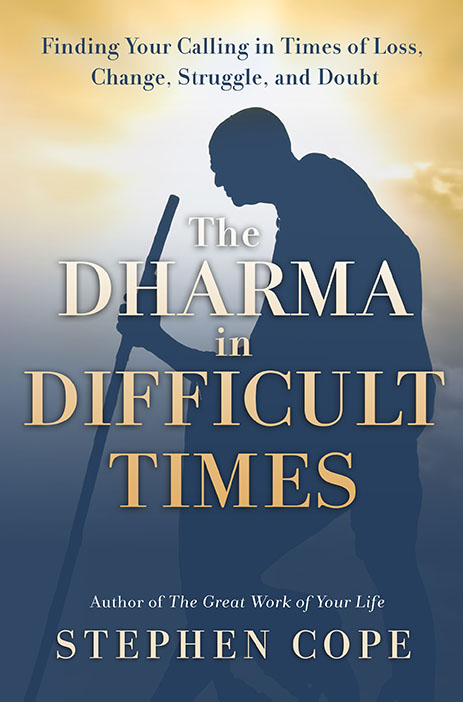By Stephen Cope – Published by Kripalu ~
 I see my own concerns about fulfillment played out nearly every day of my professional life. I work at one of the biggest holistic retreat centers in America—Kripalu Center for Yoga & Health. We see more than 35,000 people a year here in our sprawling, former-Jesuit monastery perched high up in the Berkshire Hills of Western Massachusetts. Our guests come for various kinds of retreats: yoga, meditation, self-inquiry, couples’ work, healthy living. And almost every single one of them comes here in some phase of the mission to find this secret, hidden inner possibility spoken of in the Gospel of Thomas.
I see my own concerns about fulfillment played out nearly every day of my professional life. I work at one of the biggest holistic retreat centers in America—Kripalu Center for Yoga & Health. We see more than 35,000 people a year here in our sprawling, former-Jesuit monastery perched high up in the Berkshire Hills of Western Massachusetts. Our guests come for various kinds of retreats: yoga, meditation, self-inquiry, couples’ work, healthy living. And almost every single one of them comes here in some phase of the mission to find this secret, hidden inner possibility spoken of in the Gospel of Thomas.
A true story: Whenever I teach our program participants here at Kripalu, I begin by asking them to name what they’ve come for. Seventy-five percent say it straight out: “I want to come home to my true self.” Over and over again in almost those exact words.“To come home to my true self.” Where have these people been? The same place I’ve been, lately, I guess: Unclear. Confused. Paralyzed by doubt. Gliding. Drifting. Mesmerized by the old tried-and-true distractions. (And maybe some of us have truly been in the desert).
Most of our guests come to a yoga retreat because they know by now that the yoga tradition is almost entirely concerned—obsessed, really—with the problem of living a fulfilled life. The yoga tradition is a virtual catalog of the various methods human beings have discovered over the past 3,000 years to function on all cylinders. This includes everything from the world’s weirdest diets to the most sublime forms of prayer and meditation—and ecstatic experience. One of the greatest archetypes of the yoga tradition is the jivanmukta—the soul awake in this lifetime.The soul awake. I like this aspect of yoga, because it means awake in this lifetime—not in some afterlife, or heaven realm, or exalted mental state. And so these contemporary seekers come to yoga, seeking—as I did, and do—inspiration for living.
The yoga tradition is very, very interested in the idea of inner possibility harbored within every human soul. Yogis insist that every single human being has a unique vocation. They call this dharma. Dharma is a potent Sanskirt word that is packed tight with meaning, like one of those little sponge animals that expands to six times its original size when add water. Dharma means, variously, “path,” “teaching,” or “law.” For our purposes … it will mean primarily “vocation,” or “sacred duty.” It means, most of all—and in all cases—truth. Yogis believe that our greatest responsibility in life is to this inner possibility—this dharma—and they believe that every human being’s duty is to utterly, fully, and completely embody his own idiosyncratic dharma.
Most of the people I teach here at Kripalu catch on to the idea of dharma right away. They often say that they feel comforted that someone has taken the trouble to give a name to this urgent and irksome call that has flashed in and out of their brain for so long, like a lamp with a bad connection.
Not only did yogis name this hidden inner genius, but they created a detailed method for fulfilling it. In fact, the ancient treatise in which this method is spelled out is hands down the most important and well-loved scripture in the world of yoga.
I am reffering, of course, to the 2,000-year-old treatise on yoga called the Bhagavad Gita, or Song of God. It is the world’s greatest scripture on dharma.
In India, every villager knows the story of the Gita. It is the story of the warrior Arjuna and his divine mentor, Krishna. Arjuna is supposedly the greatest warrior of his time, but really, he is just astonishingly like we are: neurotic as hell, and full of every doubt and fear you can imagine. The Gita tells how Krishna taught Arjuna—even Arjuna—to embrace his sacred vocation. In India, Krishna and Arjunaare picture everywhere, and their story is played out in temple carvings and icons of every variety, so even illiterate folk know the tale. For two thousand years, people have read or chanted the Gita daily, just as we read our Bibles, or Torah, or Koran. The Gita is the one book Ghandi took with him to prison, and one of the few that Henry David Thoreau took to Walden Pond.
***
The Bhagavad Gita is a brilliant teaching on the problems of doing. There is so much talk these days about being. (And for good reason.)But what a treat to discover a great scripture about doing. “All that is worthwhile,” says the great Jesuit scholar and paleontologist, Teilhard de Chardin, “is action.” In fact, there is no being in this world without doing. Let’s get real: Most of our lives are spent in doing. From the point of view of the Gita, the most sublime kind of doing is really a perfect expression of authentic being…
…Arjuna has many excellent questions for Krishna—questions to which we, too, would like answers: Who am I, for God’s sake? And how can I authentically express all that I truly am?
Over the course of 18 magic chapters, Krishna and Arjuna sort through these questions. Krishna gives some awesome talks about action version inaction, about doubt and faith, about knowledge and love. Arjuna hedges his way from chapter to chapter, until about halfway through the book, when Krishna at last has to really get stern with him. In the famous Chapter Eleven, Krishna pulls out his big guns—and one of the world’s most stunning theophanies explodes into the consciousness of a bewildered Arjuna. Now Arjuna really understands who he is messing with. From here on out tumble some of the world’s most inspirational teachings about devotion, love, work, and duty.
By the end of the book, these two friends have sorted out the Truth. We readers feel sorted out, too.
From the book The Great Work of Your Life, © 2012 by Stephen Cope. Reprinted by arrangement with Bantam Books, an imprint of the Random House Publishing Group, a division of Random House, Inc. All rights reserved.





